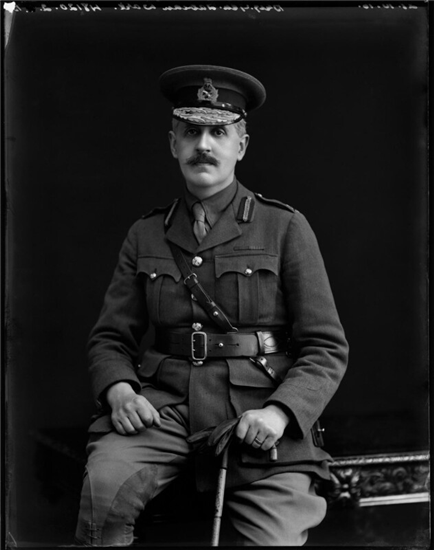Major General Sir Fabian Ware, 1869 – 1949

by Bassano Ltd - whole-plate glass negative, 27 October 1916 © National Portrait Gallery, London (NPG x154757)
Fabian Ware was born in Clifton, Bristol, where his mother ran a small boarding school. He became a teacher and, as a member of the Assistant Masters' Association, began campaigning for educational improvements. He was an “Occasional Inspector, Board of Education Examiner,” (1901 census) and was living in Hampstead. He married Anna Margaret Phibbs in 1895 and the family moved to Pretoria, South Africa, where he assisted in the organisation of their state education. When he returned to England he became editor of the Morning Post.
He visited Letchworth Garden City in 1906, which possibly gave birth to a life-long passion to preserve all that was best in architecture and the English countryside.
In 1912 he wrote a play called “The Chalk Line” that touched on the possibility of war with Germany and the blindness of pacifists. The correspondent in “The Stage” slated it as futile propaganda, which might have harmful effects!
But war came and Fabian volunteered but he was turned down because of his age. Instead he became head of a mobile Red Cross ambulance unit, leaving for France on the 16th September 1914 with the British Expeditionary Force. They were to search for missing men in the zone occupied by French forces. He was given the honorary title of major and put in charge of the newly formed Graves Registration Committee. He was subsequently attached to H.Q. Staff and made a Brigadier General.
Fabian Ware felt that the registration of graves was not enough. He wanted memorials that would last for ever, that were worthy of the sacrifice that had been made. He submitted his ideas to the Imperial War Conference and in May 1917 the Imperial War Graves Commission (IWGC) was established by Royal Charter with the Prince of Wales as President and Fabian Ware as Vice-Chairman. The difficult job of deciding how it could be done was given to Lieut. Colonel Sir Frederic Kenyon, Director of the British Museum. His full report was submitted in January 1918 (available on-line via the IWGC website). Church leaders, regimental bodies, and families of the fallen were consulted.
The memorials were all to be uniform. This decision was not welcomed by everyone. In May 1920, Rudyard Kippling, Fabian Ware and Winston Churchill addressed a meeting at the House of Commons to answer criticisms and to explain the work of the IWGC. Every stone would be let into a long concrete beam set into the ground. Fabian Ware pointed out that every gravestone would have a cross, the star of David. or a suitable Islamic symbol. Mr Churchill hoped that the government would not stand in their way.
On the 25th February 1920 he was knighted for his services as Director-General of the Grave Registration. That year he also toured the cemeteries in Gallipoli, Egypt, Aegean Islands, Palestine and Italy! He would personally accompany people of note who wished to visit a cemetery anywhere in the world, whilst also giving lectures about the IWGC.
The contract for creating the cemeteries was not fully completed until 1933, when Fabian Ware announced that it had cost £80,000,000. New IWGC stones are still being erected as bodies are identified, such as the one in Amberley Burial Ground, erected in 2016
From 1920 until he died, Fabian Ware's home was in Amberley. He unveiled the Amberley War Memorial on 25th February 1921 and in 1924 he bought Dial Cottage. On Armistice Day 1928 Fabian Ware presented the Church with one of the original wooden crosses to an unknown soldier.
He also then began campaigning to save rural England, especially the Cotswolds. The Council for the Preservation of Rural England (CPRE) was formed in 1926. In 1928 the Gloucestershire branch of the CPRE was created with Fabian Ware as Chairman.
During the Second World War, he continued with his lecturing. In his 1942 Armistice broadcast he announced that the names of over 50,000 civilians in U K, Malta, and other parts of the world had been collected for perpetual remembrances, as well as those of the fighting services. After WWII, 100,000 graves were added in Britain. In Italy and Southern Europe there are 42 cemeteries containing 45,000 graves, and seven in North Africa where there are 40,313 graves.
He retired in 1948 and became ill the following spring, dying in Barnwood House Hospital on 28th April 1949. His funeral in Amberley Church on the 2rd May was attended by the Bishop and Dean of Gloucester, and representatives from the IWGC, the CPRE,and the British Legion, as well as a packed congregation. The Amberley British Legion formed a guard of honour.
A “Truly Great Gloucestershire Man whose name needs to be remembered by all of us.” Viscount Bledsloe

Commemorative plaque In Gloucester Cathedral
Census Returns/T he British Newspaper Archive (D2299/3116)/ Land Tax Returns for Amberley 1919, p13.
Maureen Anderson